 by Jennifer Sartell of Iron Oak Farm
by Jennifer Sartell of Iron Oak Farm
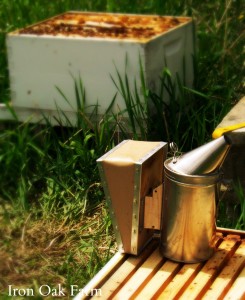 The smoker is the bee keeper’s friend. It is the saving grace which might otherwise cause a difficult relationship with your bees. It creates an atmosphere of harmony with you and your hive and it’s important for beginner bee keepers to understand why we use a smoker, and how to properly use it. Also, as a beginner, you may want to enter for a chance to win an entire bee-ginner’s kit! A prize package worth $1,600!
The smoker is the bee keeper’s friend. It is the saving grace which might otherwise cause a difficult relationship with your bees. It creates an atmosphere of harmony with you and your hive and it’s important for beginner bee keepers to understand why we use a smoker, and how to properly use it. Also, as a beginner, you may want to enter for a chance to win an entire bee-ginner’s kit! A prize package worth $1,600!
We’ve kept bees now for 3 years and Zach has only been stung once. And it was when he didn’t use the smoker.
The modern smoker we use today, the metal canister with the side bellows, can be attributed to Moses Quinby of St. Johnsville, NY in 1875. wisegeek.org
Why Smoke Bees?
It’s safer! Bee stings can be dangerous, even to someone who has been stung before. It’s important to keeps stings at a minimum to avoid adverse allergic reactions.
It also offers peace of mind for a bee keeper and keeps the relationship with your hive one of interest and amazement, rather than fear. It encourages more routine inspections and keeps bee keeping an enjoyable experience.
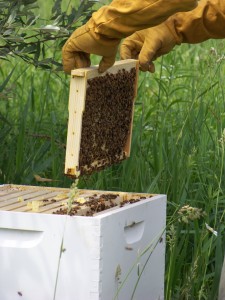 It’s also safer for the bees. A bee keeper who is calm has less reactionary movement. The beekeeper can move more slowly and deliberately. You can take time to really learn about your hive, study its activity and care for it in an educated way.
It’s also safer for the bees. A bee keeper who is calm has less reactionary movement. The beekeeper can move more slowly and deliberately. You can take time to really learn about your hive, study its activity and care for it in an educated way.
You also loose less bees while carrying out inspections. The bees are more cooperative when smoked. They move more slowly and can be carefully brushed out of the way to avoid getting squished especially when reassembling the hive.
You also loose less bees to stings.
Why Does Smoking Work?
When a bee detects smoke near the hive it senses the danger that a fire might be near by. This sets off a reactionary instinct, that preparation to move the hive is necessary. In a sense, they start “packing” to leave home. The bees begin consuming honey and nectar so they will have ample stores while they look to find a new place for their hive.
They also focus their attention on caring for the queen in this state of alarm. It’s the bee’s focus that creates a safe place for humans to work. They are concentrating on saving the hive and collecting honey, rather than what us humans are up to. It doesn’t guarantee you won’t get stung, but it can greatly decrease the instances.
The bees start to become lethargic because they are full of honey. It’s a kind of food coma, similar to the way we feel after eating a big meal. This slower activity makes the bees more manageable.
The smoke also breaks up the pheromone signals that the bees send to each other when the hive is being tampered with. Normally, if the hive was opened without smoke, the worker bees would sense the disruption and send signals to the other bees to attack! The smoke masks those pheromones and confuses the bees.
This is why it’s always important to use the smoker should you get stung. When a bee stings, it sends those same attack signals to let the other bees know that there’s an intruder. They follow suit and attack as well. The smoker stops that communication and prevents multiple stings and multiple bee losses. (A bee dies after it stings).
How to operate a smoker
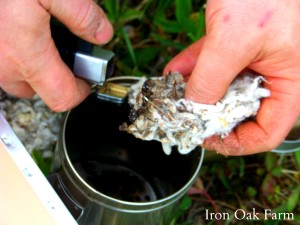 Open the top of the smoker and make a small fire in the cylinder.
Open the top of the smoker and make a small fire in the cylinder.
Fuel: Pine works as a great smoker fuel. This high sap content makes for a wet smoky fire. Pinecones, pine needles and wood chips make for great fuel. Cotton, dryer lint, or bits of paper can help get things started.
Once the fire is going, close the lid. When the lid is closed it restricts the air flow and causes the fire to smolder and smoke heavily. When the bellows are squeezed, air is forced out the nozzle hole which feeds the fire. When the bellows open, it sucks air back into the bellows.
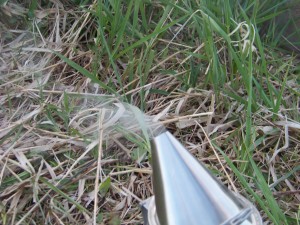 Be careful where you set your smoker while tending your bees. The outside can get very hot, in fact I still have a scar where I burned my arm on the outside of our smoker.
Be careful where you set your smoker while tending your bees. The outside can get very hot, in fact I still have a scar where I burned my arm on the outside of our smoker.
Make sure the fire is completely out, and the metal has cooled before storing your smoker.
How to safely smoke bees
Keep in mind, the smoker is not a fog machine. The point of the smoker is not to fog the bees or use the smoker like a can of bug spray.
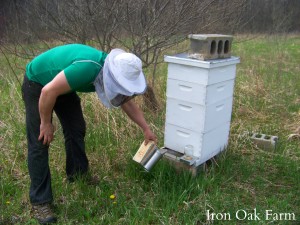 When opening the hive give a couple of puffs at the entrance. This should begin to get the hive into “prepare” mode. You might see reinforcement bees returning to the hive with great vigor. With these first few puffs the bees will start sending signals that there is a fire danger. You don’t want to mask these signals, so give the bees a few minutes to get focused.
When opening the hive give a couple of puffs at the entrance. This should begin to get the hive into “prepare” mode. You might see reinforcement bees returning to the hive with great vigor. With these first few puffs the bees will start sending signals that there is a fire danger. You don’t want to mask these signals, so give the bees a few minutes to get focused.
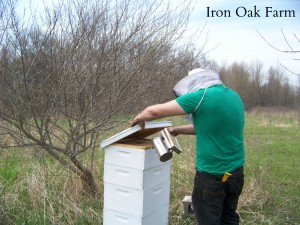 It should now be fairly safe to open the lid. Do so slowly and once cracked give a puff under the lid, holding the smoker about 8-10 inches away. You just want the smoke to drift under. Continue opening the lid and if things are ok you can continue with your work.
It should now be fairly safe to open the lid. Do so slowly and once cracked give a puff under the lid, holding the smoker about 8-10 inches away. You just want the smoke to drift under. Continue opening the lid and if things are ok you can continue with your work.
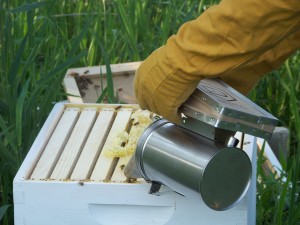 If the bees seem agitated, give a light smoke puff over each box top as you work through the hive.
If the bees seem agitated, give a light smoke puff over each box top as you work through the hive.
Sometimes returning bees will begin knocking into you as a warning. Give a few puffs around yourself to let the bees know that you are the source of smoke and to steer clear.
Carry out your work and give a puff or two every 5 minutes or so, to let the bees know that the “fire danger” is still present.
Be sure to keep an eye on your fuel source inside the smoker throughout the inspection. You want the smoker ready if you need it, so check that the fire is still going and add fuel as needed. Give the smoker a few puffs now and again to deliver air to the fire.
Have a tip to share about using a smoker? Leave a comment below or visit the Keeping Backyard Bees Facebook Page.
This Giveaway has Ended
 Just getting into beekeeping, or want to win a brand new package of equipment? One of our sponsors, Brushy Mountain Bee Farm, is giving away an amazing kit package worth $1,600 to one lucky reader! The kit includes all the educational tools to help with your beekeeping experience, and gets you started with two, fully assembled hives, the protective clothing to help you prevent getting stung, and the equipment needed to harvest and extract your honey crops. Full prize list, below!
Just getting into beekeeping, or want to win a brand new package of equipment? One of our sponsors, Brushy Mountain Bee Farm, is giving away an amazing kit package worth $1,600 to one lucky reader! The kit includes all the educational tools to help with your beekeeping experience, and gets you started with two, fully assembled hives, the protective clothing to help you prevent getting stung, and the equipment needed to harvest and extract your honey crops. Full prize list, below!
Just click here to subscribe to our free, weekly newsletter, and you will be automatically entered for a chance to win this amazing giveaway from Brushy Mountain Bee Farm!
Don’t forget to follow us on Facebook, and Brushy Mountain Bee Farm, too!
Sign up now! Sweepstakes ends at the end of 2015.
Complete Prize list:
The Ultimate Beekeeping Kit from Brushy Mountain
- 8-Frame Ultimate Hive Stand with Frame Perch
- 8-Frame Hive Stand
- 8-Frame IPM Bottom Board
- 8-Frame Assembled Garden Hive Super
- Empty Assembled 6-1/4 Grooved/Grooved Frames
- 5-5/8 No Hook Crimp Wire Foundation
- 8-Frame Metal Excluder
- 8-Frame Inner Cover
- 8-Frame Garden Copper Top
- 8-Frame Entrance Reducer
- Folding Hatless Veil
- Plastic Coated Gloves
- Brushy Mountain Smoker
- 1-pound Premier Smoker Fuel
- 10-inch Hive Tool
- Frame Grip
- Bee Brush
- 8-Frame Escape Screen
- Cold Knife
- Cappings Scratcher
- Multi-Use Straining System
- Multi-Use Straining System Top
- Multi-Use Straining System Upper Unit
- Multi-Use Straining System Lower Unit
- Multi-Use Straining System Screen
- Plastic Gate
- Cross Bar for Multi-Use Straining System
- Multi-Use Nylon Filter
- Compact Extractor
- 5-Gallon Filtering System
- 5-Gallon Bottling Unit
- 600-Micron Coarse Filter
- 400-Micron Medium Filter
- 200-Micron Fine Filter
- Plastic Gate
- 5-Gallon pail Lid
- Backyard Beekeeper Book
- Bee Culture Subscription
- English Garden Hive DVD
- Online Beginner’s Class CD
- Master Beekeeper Suit
- Clear Vue Hat Veil Combo
- Cowhide Ventilated Glove










33 Comments
Am Startin My Apiary In Northern Uganda And Hope Will Get Online Friends For Guidance
I have no comment.
I’ve wanted to keep bees ever since I visited a friend who had an apiary. I’m a gardener and this just seems the next natural step. I think tthe article was most informative. Thanks. ..
love my little honey bees
Thanks for the info. When do I get my prize?!
first time I used my smoker I ran out of fuel. I was using it too much. Can’t wait for the weather to warm up to start with my first bees.
I have ordered a hive for next year and am trying to learn as much as possible. My daughter, granddaughter and myself are going to keep the bee’s because we love honey and would like to have our own source. This article is very helpful and I will have both of them read it.
Thank you
Ann
The story mentioned dryer lint, among other things, to get the fire started – do not use dryer lint unless you know for sure it is ONLY cotton lint, and that the cotton has no chemical additives, etc(synthetic fabric will create toxins when burned)..I would suggest not using dryer lint at all; there are so many other good fire starters..
I would love to win the beginners kit. I have always wanted to keep bees but all of that equipment is just not affordable to me.
Looking forward to moving to the country sometime next year. I have long had interest in bees, and concern over the demise of so many hives. I want to do whatever I can to encourage the proliferation of bees because they are so necessary in preventing our own demise!
enter me into sweeps. thanks
Honey is the only sweetener I use since the early 70s. I have been interested in raising Bees
For too long. I am 64 living on disability I can not afford the capital to start. I would love to win this
and make one of my dreams come true…
One of the best tips I got to light a smoker is to have a MAPP gas torch handy: The fire is super hot and will ignite at the push of a button. (better than wet matches when you have gloves on and your smoker goes out!)
I keep it in my beekeeping bucket with several hive tools, little hammer, crayon to mark the hives if I suspect a problem, pliers. It is better to have all the tools in one place than drive miles to your bee yard to find out you forgot something.
Besides that, you should take the time to light a proper fire in your smoker so you don’t have to re-light while your girls get antsy.
This would be GRRREAT for my brother’s bees!!!
Here in the Midwest; we have been laboring to keep our bees healthy. Keep up the good work and keep giving us good advice.
Great article, brings back many fond memories of my childhood helping my father take care of his bees! We had 40 hives at a near by farm and I only remember getting stung a few times! That smoker worked wonders! My husband and I would love to raise bees! We have a small orchard and tons of raspberry, strawberry, blueberry and current berries, plus vegetables!
This would be a great way to get started!
We are a new educational campus that is gearing up to teach all phases or permaculture living. Thank you for a very informative web site.
I like to sit my smoker on the up wind side of my hive so that a light stream of smoke is blowing by throughout keeping them calm.
Great art i cal thanks
New to beekeeping this season. I found a great smoker fuel source, and it’s right under your mower deck. If you get clumps of wet, compressed grass that dries and sticks under your mower in the spring, it’s like a cake of fuel that can be broken up for the smoker, it’s all natural, and a few big chunks will get you through a season if you are only working a couple hives. Must be dried thoroughly to burn well.
I use dried pine needles and cones, I keep them in a paper grocery bag to ensure they’re really dry and when I need a big wad I just pull it out and stuff my smoker full, then I hollow out the center and use a long lighter to light inside the center, works like a charm.
I have two hives. I don’t fill my smoker to the top with burnables, but it still stays lit far longer than I need it. What’s the best way to put the smoker out when you are done with it?
How long after you smoke the bees and finish what you’re doing, does It take for the bees to go back to work as normal, before they was interrupted???
It can be a great way to get started. Thank you for sharing this amazing article.
Good informative article. I put a cork from a tequila bottle in the smoker’s spout when I want to put it out. Then when the smoker feels cool I set it into a large galvanized bucket before I drive home.
I would like to hear more as I am a raw beginner.
You asked for other tips – if you use cloth, make sure it is only cotton. Do not burn anything that’s poisonous to you because it can be poisonous to the bees as well, so never use nylon, rayon, or polyester synthetic cloth. You want a white, cool smoke, not a hot black one. Also, a lot of times we’re done working the bees and we still have fuel left in the smoker. A great way to put it out without losing all of that is simply to plug the front spout. Use a cork, or get a smoker plug. That takes away the oxygen and will put the fire out in a couple of minutes. Be sure to put the smoker on something that is fire proof when putting it down. Not on anything plastic like a portable plastic table or the top of a plastic bin! It will melt it. If you have nowhere else to put it down, just put it on the ground. Hope this helps!
Thanks for that info… cleared up a few smoky questions
Thank you for this great article. I liked your way of presenting this amazing article.
Recently joined Facebook’s “women in beekeeping’ group. Investigating posts and read this article. Its THE best advice I’ve ever read/heard of on smokers! I realize this was posted many years ago but is still correct! Please post it again!
I live on 20 acres in the mountains. We have several berries and wild flowers. I’m very interested in keeping bees. Your information is appreciated. Will you be doing another sweepstakes for a bee kit? Thank you!